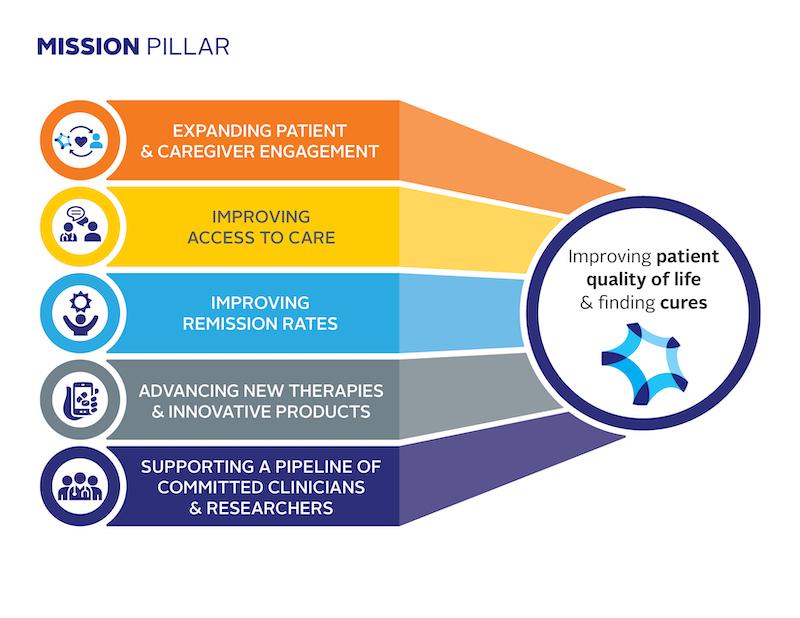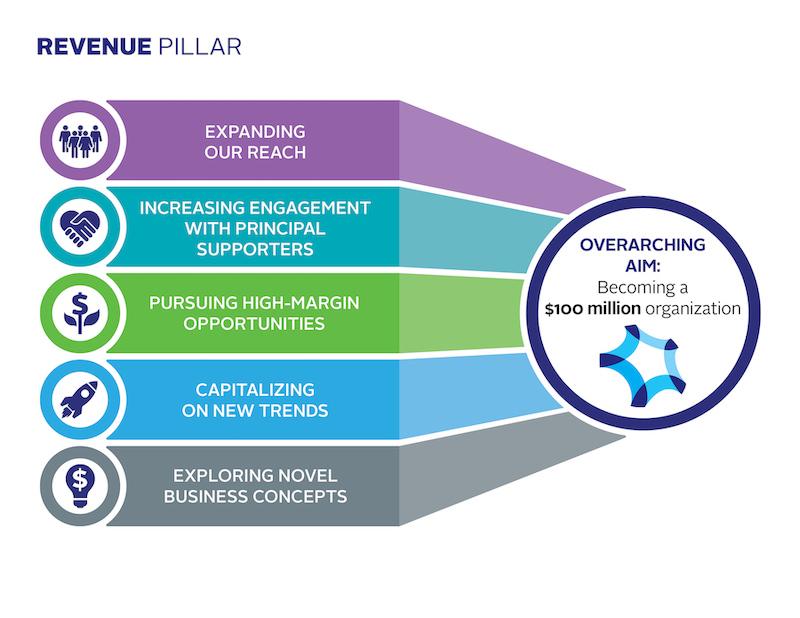Several concepts drove the development of all of our strategies:
Strong and Diverse Patient Focus
Patient centricity is at the heart of everything we do, and we strive to ensure that the diversity of patient experience is reflected in all of our initiatives and programs.
Impact Driven
The Foundation will establish key metrics and critical milestones for all initiatives, to clearly demonstrate success as we move toward ensuring and consistently delivering and communicating positive impact on the IBD community and the accomplishment of our mission.
Agile Innovation
Mindful of the uncertainty of the future and the need to be innovative in the face of that uncertainty, we will use an agile method of project management fostering a nimble approach to creating and implementing new initiatives.
Creating Operating Efficiencies
The organization will look to achieve some of its common objectives by actively exploring the centralization of shared activities and will identify and advance synergies across areas of our business.
Building on Our Strengths
We will build on what we already do well, such as developing and expanding mission activities that consistently assess and respond to patient needs, fostering a highly diversified and mission-driven revenue portfolio, and integrating volunteers into all aspects of the business. We will explore further innovating in those areas and maximize our core strengths.
Volunteers
In every area of the business, we aim to expand the volunteer ranks, further engage them in the work of the Foundation, and activate their skills and resources to advance all key activities of the Foundation.
Objective #1
Expanding patient and caregiver engagement
Expand the active involvement of patients and caregivers in the development and execution of the Foundation's mission strategic objectives in order to ensure more inclusive programming that meets patient needs.
Strategy #1
Engage patients and caregivers who represent the diversity in the IBD community (race, ethnicity, age, gender, disease experiences, and other factors) in all mission activities to ensure that Foundation programming is inclusive and responds to the needs of diverse patients.
Strategy #2
Ensure that best practices for engaging these diverse patients and their caregivers are developed and are used as standard practice across mission programming, including advocacy, awareness, education, support, and research.
Objective #2
Improving access to care
Improve access to timely diagnosis and management of care for patients with IBD through a variety of methods, including education, awareness, advocacy, and use of real-world data (health-related data generated directly from patients or during routine clinical care), in order to improve health outcomes.
Strategy #1
Develop educational and awareness programs for patients, caregivers, and providers to improve patient access to multi-specialty providers who can provide care
as appropriate for their medical needs, in order to reduce the average time to diagnosis and improve health outcomes and satisfaction with IBD care.
Strategy #2
Engage industry, payers, and governmental agencies with the use of real-world data generated through IBD Plexus® (the Foundation’s data platform and biobank characterizing the full picture of patients’ disease journeys), and other data sources, to advance discussion on the cost of care and improving access to IBD care, including a focus on medications covered by insurers.
Strategy #3
Expand the Foundation's state and federal advocacy efforts and empower patients/caregivers with tools to help them better address insurance-coverage decisions to improve patient access to affordable care.
Objective #3
Improving remission rates
Improve IBD patient remission rates through initiatives focused on the key drivers of disease diagnosis, progression, and management in order to improve the quality of life of patients living with these diseases.
Strategy #1
Implement an evidence-based clinical approach within the growing IBD Qorus network (the Foundation’s quality of care program), to achieve greater remission rates. Make the broader IBD provider and patient community aware of the learnings from this initiative to emphasize the importance of managing toward remission.
Strategy #2
Develop evidence-based decision guidance regarding diagnosis, disease progression, and management using data from IBD Plexus® and other sources. Create and promote educational programming for patients, caregivers, and professionals to share our research results in order to have a broader impact.
Strategy #3
Fund – and advocate for external funding of – research that accelerates understanding of 1) the biological mechanisms underlying disease remission, such as the normal state of the mucosa, healing, and relapse, and 2) key clinical drivers of remission, in order to generate research findings that lead to better management strategies and higher remission rates.
Objective #4
Advancing new therapies and innovative products
Advance new therapies and innovative products by supporting the discovery and development of those that address unmet patient needs across diverse populations, leading to improvements in patient quality of life and cures.
Strategy #1
Provide funding and other resources to outside institutions and companies to speed the development of new products that address unmet patient needs.
Strategy #2
Move forward specific therapeutics and diagnostics that can be uniquely addressed by the Foundation through internally managed research programs that take advantage of IBD Plexus resources. The goal of these efforts would be to advance the products to a stage where an outside entity would develop them further in order to be used for patient care.
Strategy #3
Advance the discovery, validation, and use of biomarkers through the use of Foundation resources and partnering with key stakeholders to advance precision medicine in IBD.
Strategy #4
Accelerate enrollment of patients into clinical trials by engaging key stakeholders, including patients and caregivers from diverse communities, providers, industry partners, and regulatory groups, in order to more quickly advance promising therapeutics towards regulatory approval
Strategy #5
Support research that addresses unmet clinical needs across diverse populations by improving understanding of the underlying human biology, using bedside to bench approaches that can lead to new drug targets and biomarkers.
Objective #5
Supporting a pipeline of committed clinicians and researchers
Attract, support, and develop a pipeline of innovative and successful clinicians and researchers to advance the Foundation's research priorities and educational programs.
Strategy #1
Support the career development of future leaders in IBD research who are aligned with the Foundation’s mission, through the flagship training and junior investigator awards, with attention to representation across gender and those from backgrounds traditionally underrepresented in medicine.
Strategy #2
Continue existing and develop new programs and processes to engage trainees, both clinicians and researchers, as well as junior investigators, in priority research areas and educational programs for the Foundation.
Strategy #3
Create mechanisms to support mentoring and leadership experiences for junior investigators, which are focused on enhancing their ability to obtain subsequent funding and leadership opportunities to support their careers in IBD research.
Objective #1
Expanding our reach
Expand the total number of people connected with the Foundation through involvement with mission programs, awareness-building efforts, and fundraising activities to drive greater volunteerism and support.
Strategy #1
Test and launch activities to attract new constituents including those who represent the diversity in the IBD community (race, ethnicity, age, gender, disease experiences, and other factors) through multiple channels, including awareness and familiarity-building methods, and leveraging new communication and messaging approaches.
Strategy #2
Ensure that new constituents are appropriately and consistently stewarded from the moment they first make a connection with the Foundation, regardless of the channel through which their Foundation journey began.
Strategy #3
Invest in marketing and technology solutions, people, and processes as well as analytics to support the above strategies for attracting and stewarding new constituents, and to learn what works in order to continually refine strategies and achieve greater reach.
Objective #2
Increasing engagement with principal supporters
Deepen engagement with the Foundation’s top 20% of volunteers, fundraisers, and funders to drive an increase in their giving and expand their partnership in driving increased support from other stakeholders.
Strategy #1
Identify the top 20% and facilitate the ability to analyze, track, and support engagement activities with this target audience.
Strategy #2
Design messaging and high-touch cultivation tools that deliver enhanced resources to ensure this audience has a strong and meaningful connection to the Foundation.
Strategy #3
Design and implement engagement tools, including trainings, educational events, and recognition activities to activate the top 20% in driving new revenue.
Strategy #4
Design and implement resources to equip the top 20% in further activating the next 10%.
Strategy #5
Develop enhanced cultivation and solicitation efforts focused on increasing gift levels from five- and six-figure institutional funders.
Objective #3
Pursuing high-margin opportunities
Expand successful revenue streams with high profitability margins that exhibit potential for continued growth.
Strategy #1
Analyze which existing fundraising programs have the most significant future growth potential.
Strategy #2
Resource “growth revenue streams” with necessary human and technology support to accelerate growth.
Strategy #3
Develop processes for understanding, evaluating, and showing the value to stakeholders of their partnership with the Foundation.
Strategy #4
Explore new business partnership opportunities with mission-aligned industries, including telehealth, payers, and other health non-profits.
Objective #4
Capitalizing on new trends
Build on several newly-emerging revenue generation trends, including Do-It-Yourself (DIY) fundraising activities and virtualized events.
Strategy #1
Refine approach to virtualizing elements of fundraising activities through external benchmarking and our collective Foundation experience in order to expand the reach to, and enhance the experience of, participants.
Strategy #2
Design infrastructure and resources to enable a greater number of constituents to engage in DIY efforts across revenue campaigns.
Strategy #3
Invest in technology solutions, people, and processes to capitalize on identified revenue generation trends including virtualization and DIY.
Strategy #4
Monitor and assess additional internal, early experiences and external trends to identify new expansion opportunities as they emerge.
Objective #5
Exploring novel business concepts
Develop at least two entirely new business concepts to further diversify sources of revenue.
Strategy #1
Engage in a process for ideating and piloting entirely new business concepts.
Strategy #2
Identify and pursue untapped niche audiences, and novel approaches to attracting them to the Foundation.
Strategy #3
Invest in technology solutions, people, and processes to attract and engage new audiences and to facilitate the implementation of novel ideas.


